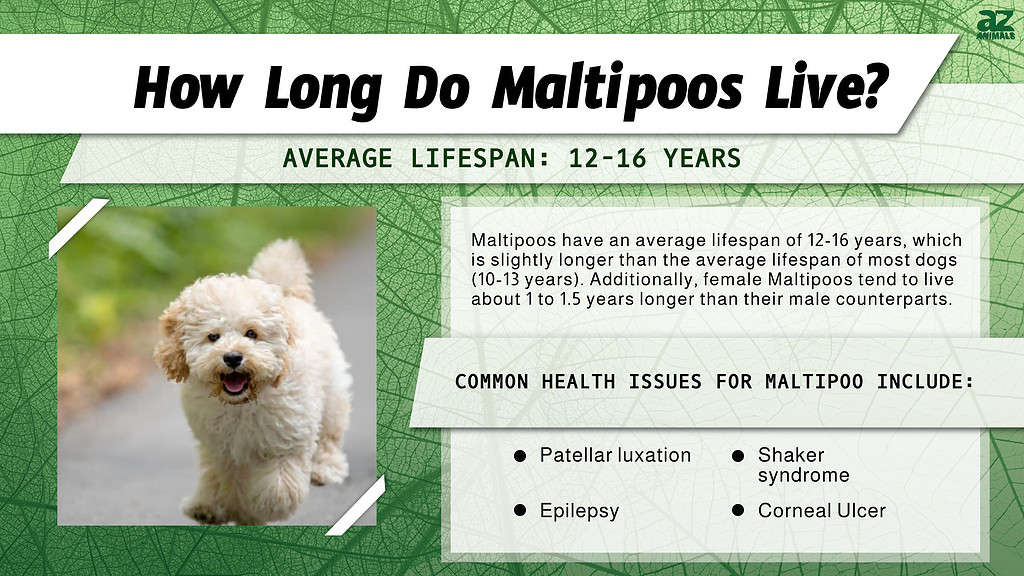
Do you want a little, adorable dog that is both friendly and good-natured? Then the Maltipoo dog breed may just be the one for you!
A Maltipoo is a hybrid between a Poodle and a Maltese. Maltipoos are an incredibly affectionate and loving dog breed. Many dog owners also admire them for their silky coats and lively temperament. They are incredibly sociable and outgoing – which is perfect if you’re looking for a new best friend.
Do you want to know more about this gorgeous dog? Then you’re going to want to read on!
We’ve got the scoop on them, including the average Maltipoo lifespan and what you can do as an owner to keep them healthy and happy.
How Long Do Maltipoos Live?

Maltipoos live between 12 to 16 years.
©Rita Petcu/Shutterstock.com
The average Maltipoo lifespan is between 12-16 years. Although the average lifetime of all canines is between 10 and 13 years, smaller dogs, such as the Maltipoo, have a somewhat longer life expectancy. You might also be interested to know that female dogs live roughly 1 to 1.5 years longer than male dogs.
Since they are smaller in size, Mini and Toy Maltipoos live longer than their regular-sized counterparts. When comparing the Maltipoo lifespan to the Maltese and Poodle, the averages are quite similar. The average Maltese lifespan is between 12-15 years, and the average Poodle lifespan is between 12-15 years.
Overall, the Maltipoo is generally a quite healthy breed of dog that doesn’t have very many health issues. With all of this knowledge on the Maltipoo at our disposal, let us now explore the many stages of its incredible life cycle.
The Average Maltipoo Life Cycle
Our dogs are important to us as members of our family. As such, it’s fun and fascinating to have a better understanding of their life cycle. Let’s explore the main stages of the Maltipoo life.
Newborn

Just like other dog breeds, Maltipoo pups are born blind and deaf.
©dimdiz/Shutterstock.com
At birth, the Maltipoos’ eyes and ears are both shut. They cannot see or hear, and they rely on their mother for all of their care and protection. Their primary activity at this stage is to feed and rest as they continue to grow. Newborn Maltipoo pups sleep the majority of the time, typically up to 90% of the time. They frequently twitch and shift while sleeping to reposition their bodies.
Puppies
The eyes of a Maltipoo puppy open at two weeks of age, followed by the ears a few days later. The puppies get more daring and begin to move about more. They are fascinated by toys and will examine every new thing presented their way. If given the chance, they will acquire problem-solving abilities as well. This is a great stage to begin introducing them to other puppies and humans as well. It’s also optimal to start getting them trained as well, as this will help prevent behavioral issues later on.
Adulthood
Toy or Tiny Maltipoos achieve mature weight and size between 9 and 11 months. Miniature and medium Maltipoos reach maturity between 11 and 13 months. Any troublesome behaviors that have not been eliminated after one year will have set in, and the work required to erase such behaviors will be considerably larger. You will begin to see your Maltipoo’s personality really shine by the time it reaches adulthood. It will fit in perfectly with your family and will love spending time with you.
What Factors Impact The Maltipoo Lifespan
Because purebred dogs have a restricted gene pool, certain breeds may experience recurring health difficulties. Mixed-breed dogs have a bigger gene pool, which reduces a dog’s chances of acquiring certain health conditions.
While this is good to a point, it then creates a new difficulty. It is more likely that a mixed-breed puppy will develop the same health problem if both parents are predisposed to it.
Some of the factors that will undoubtedly decrease your Maltipoo’s life, based on data, include:
- Digestive issues: It is not fairly unusual for a Maltipoo of any age to have gastrointestinal problems. The Maltese are more prone to gastrointestinal difficulties than other breeds, and it is from this breed that the Maltipoo acquires this difficulty. Certain digestive issues include inflammatory bowel disease, glycogen storage disease, and portosystemic vascular anomalies.
- Ear infections: Ear infections in Maltipoos can be caused by a variety of factors. Ears that have not been adequately dried after bathing or swimming might harbor germs. Excessive wax accumulation may also clog the ear, causing infection.
- Allergies: Maltipoos have a tendency to have a variety of allergies that can negatively impact their health. These allergies can include food allergies, contact allergies, or environmental allergies. It is important to pay attention to your Maltipoos behavior and see if there are any changes in their skin appearance or itching or more.
How To Extend The Life Of Your Maltipoo

Maltipoos are highly sociable and friendly, and they readily adapt to various household environments.
©OlgaOvcharenko/Shutterstock.com
Maltipoos are lovable dog breeds that can live for a long time. While many factors are beyond our control, there are actions that we can take as dog owners to ensure our dogs lead happy and healthy lives.
Some of these actions to increase the Maltipoo lifespan include:
- A well-balanced diet: You can keep your dog from becoming overweight or ill by feeding it nutrient-rich, healthful food. Most Maltipoos thrive on a dry food diet high in natural ingredients. Along with that, you must ensure that you do not overfeed them and that you only feed them during designated mealtimes. Avoid foods with fillers and ingredients that might trigger your Maltipoo’s digestional issues.
- Enough exercise and socialization time: Make sure you get at least 30 minutes of active play with your Maltipoo every day. This might involve anything from walks to indoor playtime. Exercising your dog can help with a variety of issues, including obesity and heart illness. It can also help you teach your dog certain instructions and control. It’s also great to introduce them to other dogs for social time. This helps them pick up cues and other good habits as well.
- Regular check-ups: You should make sure to take your dog to the vet at least once or twice a year. Don’t forget to have your dog vaccinated as well to keep them protected from harmful infections.
The photo featured at the top of this post is © OlgaOvcharenko/Shutterstock.com
Ready to discover the top 10 cutest dog breeds in the entire world?
How about the fastest dogs, the largest dogs and those that are -- quite frankly -- just the kindest dogs on the planet? Each day, AZ Animals sends out lists just like this to our thousands of email subscribers. And the best part? It's FREE. Join today by entering your email below.
Thank you for reading! Have some feedback for us? Contact the AZ Animals editorial team.






